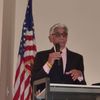The Taliban have announced that this year's fighting season begins this week. They have dubbed this year's operation as Azem, an Arabic word also used in Dari and Pashtu, the two main languages of Afghanistan. Azem means to decide and/or persevere depending on the context. Ever since the Taliban's resurgence circa 2006, the pattern has been the same. Although the winter inclement weather imposes a lull, sporadic suicide bombings, assassinations and attacks on security forces continue. Many mountain passes between Afghanistan and Pakistan, especially in the east, become impassable as a result of snow fall. Despite the southern Afghan Pakistani border areas typically not being affected by the snow fall, fighting slows down in Kandahar and Helmand also.
This pattern of fighting in Afghanistan is nothing new, but what is noteworthy is that the Afghan National Security Forces (ANSF) will this year face the enemy without the full support of the U.S. and its NATO and other coalition forces. The new NATO mission in Afghanistan called Resolute Support with roughly 13,000 troops has a mostly advisory role. Resolute Support's mandate also includes assisting and training ANSF. It is conceivable that under the assist clause NATO will occasionally provide direct military support in the form of close air support, communication, intelligence and other areas which ANSF lacks.
Another added dimension to this year's fighting is the emergence of groups from the ranks of the Taliban who have pledged allegiance to the self-declared Islamic State (IS) terrorizing vast areas in Iraq and Syria. This development has alarmed many people in Afghanistan including some warlords calling on the Afghan President Ashraf Ghani to strengthen ANSF and improve the overall political/economic condition of the country. The Taliban seem to be concerned with the rise of IS also as the old guard fears that their influence could be at stake. Some Afghans look at the rift between the classic Taliban and the new elements beholden to IS as welcome news. They contend that this rift can be exploited to weaken the insurgency as a whole using a "divide and conquer" strategy. The foreign terrorists including some from Uzbekistan who have been active in Northern Afghanistan are now calling themselves followers of IS or Daesh as they are called in Arabic speaking countries and Afghanistan. The Afghan (classic) Taliban recently for the first time published Mullah Omar's biography which is a departure from their past practice. The reclusive and publicity-shy Mullah Omar, has not been seen in public for over a decade. It is believed that the Taliban are concerned about the IS outreach into their turf. And the reason for this publicity is to reassure the foot soldiers, mid-level commanders and other followers that he is still relevant and in charge of the Taliban movement.
The security situation has taken center stage at the Afghan parliament's lower house or the Wolosy Jirga. The Interior minister along with the high ranking officials from the defense ministry and the intelligence services were summoned last week to testify on the recent security developments. The Interior Minister, Ulomi reassured the parliamentarians that ANSF is ready to deal with the challenges. He stated that the ANSF have been given clear orders to deal mercilessly with the insurgents regardless of their affiliation and national origin. Mr. Ulomi also announced a number of measures relative to the badly needed reforms within the national police structure. This fighting season will test the willingness and the capability of the all-volunteer Afghan security forces. One of the major challenges facing the Afghan government is the high attrition rate of the forces, among others including low morale, inadequate education and training. The international community led by the U.S. is footing the bill to pay for ANSF to the tune of about $4 billion per year. We will have to see what Afghanistan, the U.S. and others will get in return.
Afghanistan was a viable nation state prior to 1978. Along with other attributes of a viable nation state, she was able to pay for its defense needs through a conscript army and police force from all tribes and ethnic groups made possible by a legitimate government. This can be a model for the Afghan current government to follow, but this requires a political correction to once again legitimize the government in the eyes of the disaffected rank and file Afghans.
